Are you planning on exploring the temples and ruins in Siem Reap?
With over 100 stone temples lying around the city, we’ll show you the most visited landmarks.
Besides Angkor Wat, there are more unique structures to see in Angkor Archaeological Park.
Here are the best temples and ruins to see in Siem Reap.
1. Angkor Wat
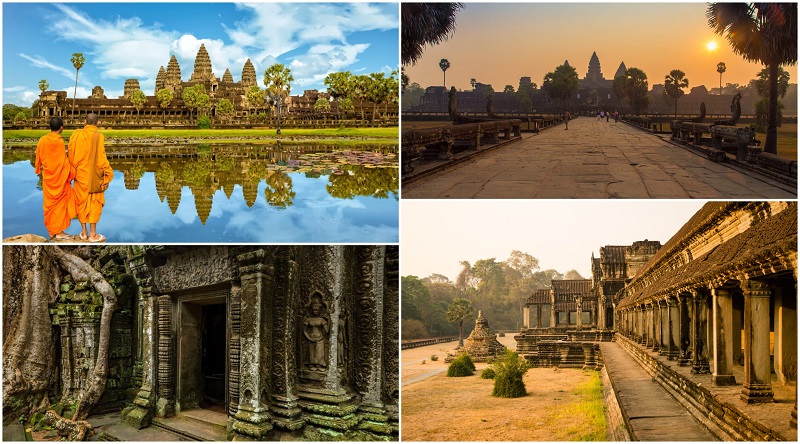
If you only have time to see one temple, Angkor Wat is the must-see attraction.
It is the largest religious structure in Angkor Archaeological Park.
For hundreds of years, visitors have been awed by it’s stunning design.
Visit at sunset or sunrise to capture incredible photos of Angkor Wat.
2. Angkor Thom
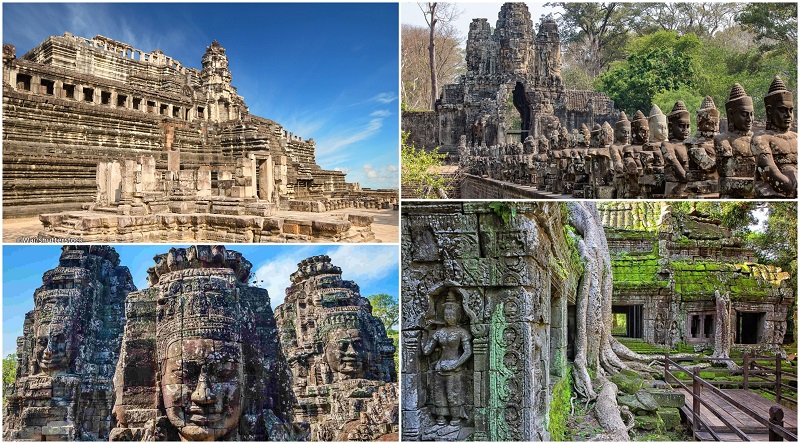
Angkor Thom embodies the power of the old Khmer Empire.
This city once supported perhaps a million people.
For centuries, it was the capital of the empire.
After Angkor Wat, it is one of the most popular tourist spots in Cambodia today.
Everything about Angkor Thom is massive.
It is surrounded by a large wall with enormous gates.
This was once guarded by an impressive moat believed to be filled with ferocious crocodiles!
3. Bayon
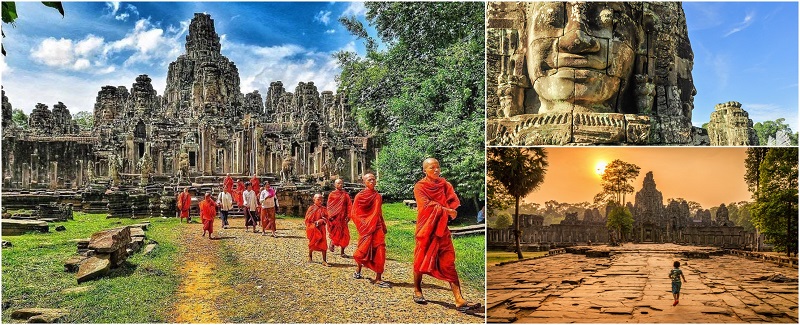
Built by the legendary king Jayavarman VII, Bayon stands at the center of the old walled city.
216 coldly smiling faces decorate 54 gothic towers.
You should visit Bayon just after sunrise when the sun inches upwards, lighting face after face on the sides of the temple.
4. Baphuon
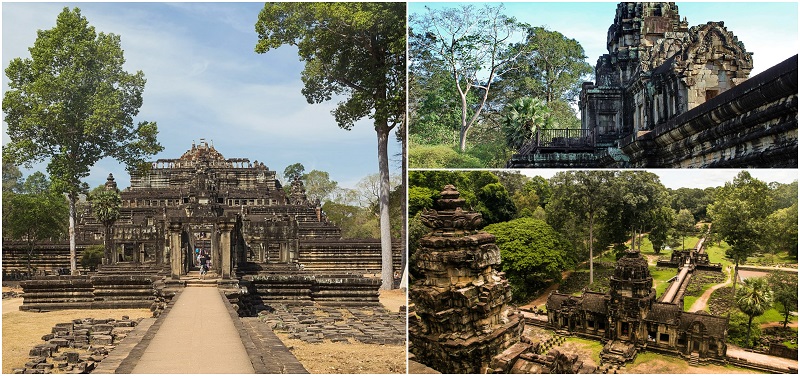
Baphuon is a temple located within a walking distance from Bayon.
One of the most prominent elements is a Buddha laying down, built around the western wall, which has never been finished.
It took almost half of a century and a lot of failed restoration attempts for the temple to open its gates to tourists, in 2011.
The final restored product is very popular among visitors.
5. Terrace of the Leper King
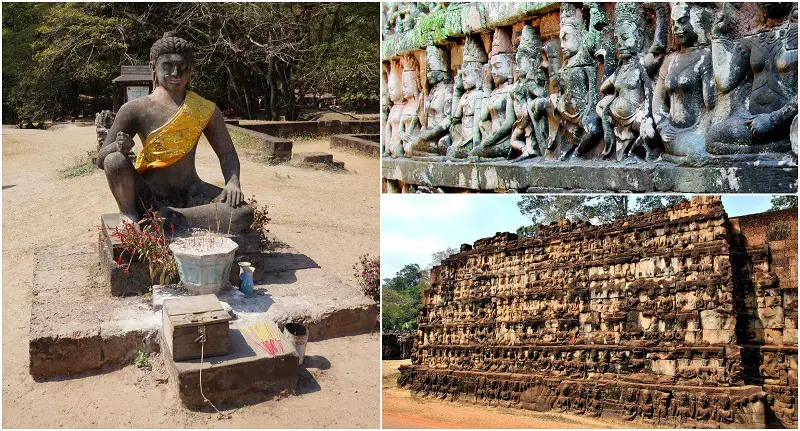
The Terrace of the Leper King is one of the great mysteries of Angkor.
On top of the 7 meter tall platform stands a nude, sexless statue.
The statue standing today is actually a copy of the original statue.
Like Jayavarman VII’s other buildings in Angkor, the face of the terrace features impressive bas-reliefs on the interior and exterior.
6. Neak Pean
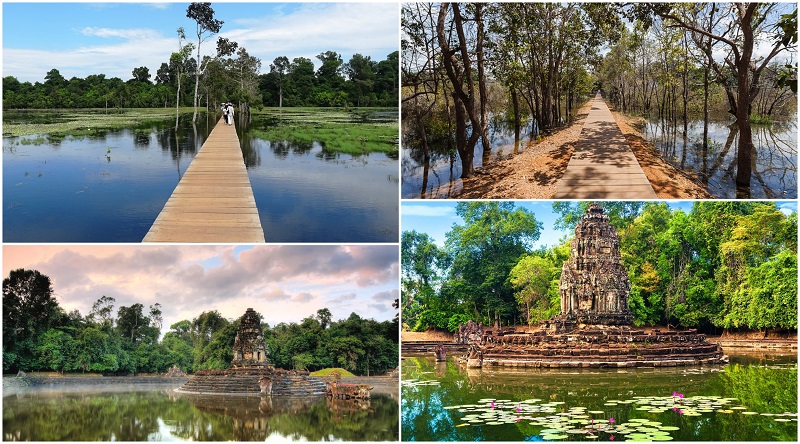
Neak Pean is a small Buddhist temple of Khmerian era, built on an artificial island.
A pool surrounds the main temple and four chapels are guarded by Balaha, the horse king.
Neak Pean displays several Hindu images as well.
The temple offers a great photo setting during the rainy season.
7. Krol Ko

Located close to the Neak Pean, Krol Ko is a small Buddhist temple with very few tourists.
The construction comprises of one tower and the ruins of a library situated between two walls made of laterite.
Its name literally means “Park of the Oxen”.
The highlights of the attraction are two pediments, one bearing a representation of Avalokitesvara and the other one of Krishna.
8. Banteay Samre
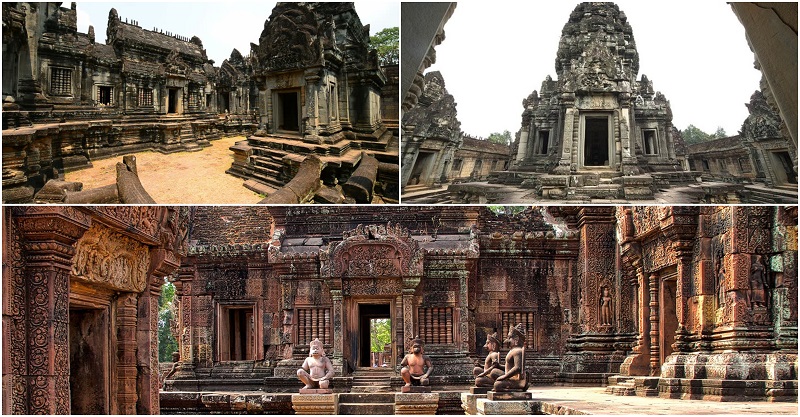
Located 400m east of East Barray, Banteay Samre is a Hindu temple of elaborate architecture and carvings.
The large sandstone and laterite construction is a fine example of the Angkorian style.
As you explore the area, you’ll notice the temple comprises of four gopuras and a sanctuary.
9. Banteay Chhmar
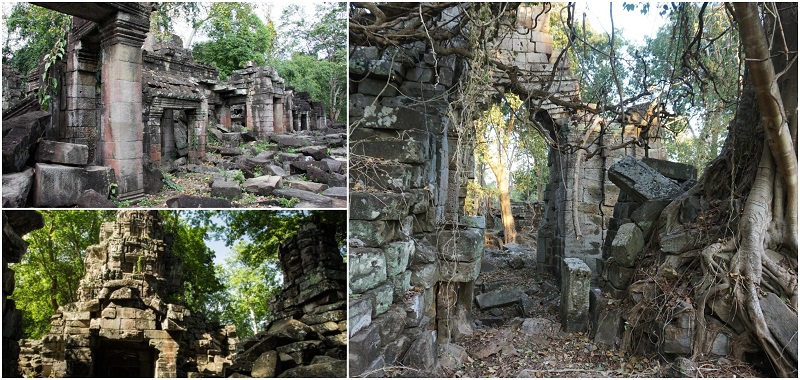
Located in North-Western Cambodia, Banteay Chhmar is a temple complex dating from the Angkorian era.
It was built during the reign of King Jayavarman VII and it’s one of the most mysterious treasures of Cambodia.
Here, you have to pursue your own adventure through the jungle and rough terrain to discover it.
Visited by less than 1000 tourists per year, this temple complex offers an enchanting experience and a great set for photos.
The Banteay Chhmar Community-Based Tourism (CBT) made the site more accessible to tourists by providing means of transportation, accommodation, food, and tour guides in English.
10. Phnom Krom
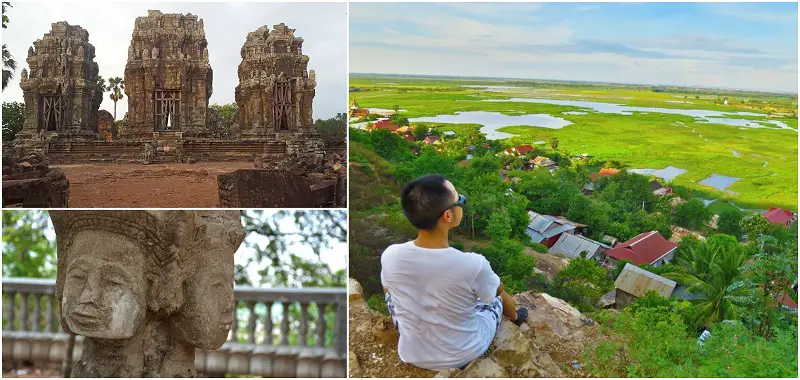
Phnom Krom is an ancient temple located on a hill bearing the same name, 15 km away from Siem Reap.
Three towers remain and they are dedicated to the Hindu gods’ trinity: Shiva, Vishnu and Brahma.
Carvings on the sandstone towers have dissipated over time.
Phnom Krim is located in the northern part of Tonle Sap Lake where boat trips are available for tourists.
The hill offers a panoramic view of the area and the lake.
11. Kbal Spean

Kbal Spean is more secluded than the other monuments of Angkor, lying on the slopes of the sacred mountain of Phnom Kulen.
They are a group of sandstone pieces bearing carvings of Hindu gods.
Apart from the Hindu mythological motifs, the carvings also represent animals and birds.
The gods represented in the carvings are the Hindu trinity – Brahma, Vishnu and Shiva – as well as other important mythological figures and symbols, such as the lotus flower.
Kbal Spean used to be known as the River of Thousands Lingams, because of the phallic Brahmanian symbols that are located along the river.
12. Beng Mealea
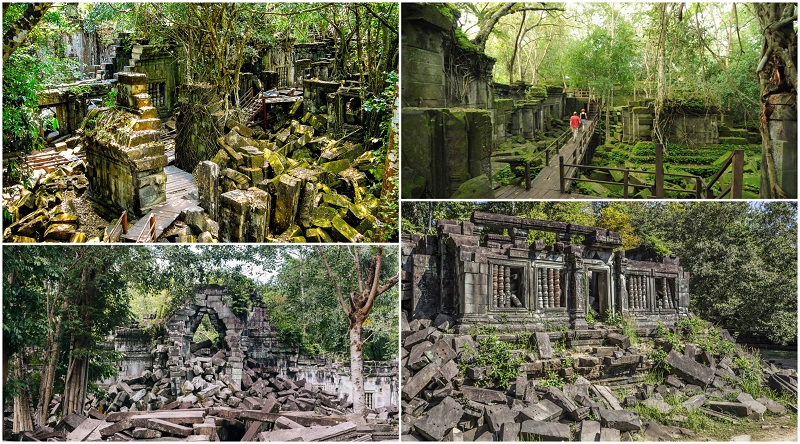
Beng Mealea one of the more mysterious edifices in Cambodia.
Until recently it was impossible to reach.
Situated 77 km away from Siem Reap, the newly built road to Koh Ker has its starting point in town.
Architects have approximated that Beng Mealea is characteristic to the period of Suryavarman II (early 12th century).
Its thick trees are similar to Ta Phrom.
The sandstone ruins of Beng Mealea feature three galleries that surround what used to be the sanctuary of the edifice.
The carvings on the walls tell stories from the Hindu mythology; the most famous of them is the Churning of the Ocean of Milk.
13. Lolei
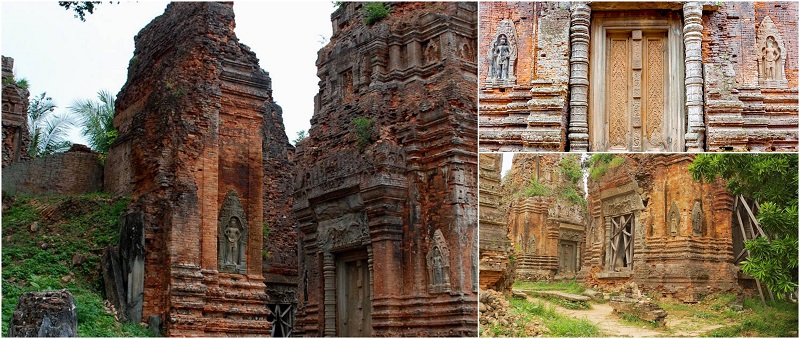
Lolei is located in the most northern point of the Roulos temple group.
Built by Yasovarman I, it comprises of four towers brought together representing Shiva, king’s parents, and grandparents.
A closer look will show displays of Khmer carvings in artistic calligraphy on the door.
Also, the brick towers feature numerous decorations, many of which are representations of Indra, the sky god, and Airavata, his elephant.
14. Preah Ko
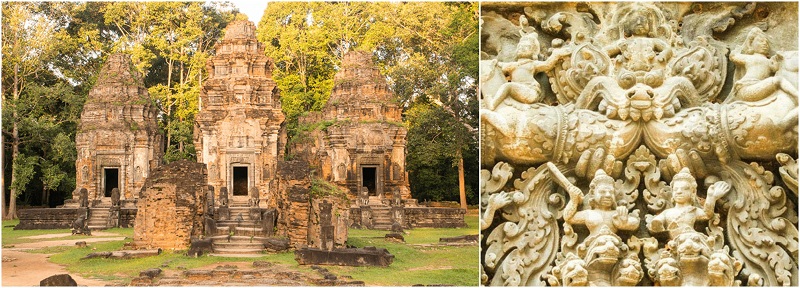
Preah Ko literally means Sacred Bull, and it refers to Shiva’s mount, Nandi.
The attraction consists of six towers in two rows, facing east.
Preah Ko shows three generations of Indravarman’s ancestors.
The front central tower is dedicated to Jayavarman II, the founder of the Khmer empire, while the central towers bear carvings of Shiva.
15. Bakong
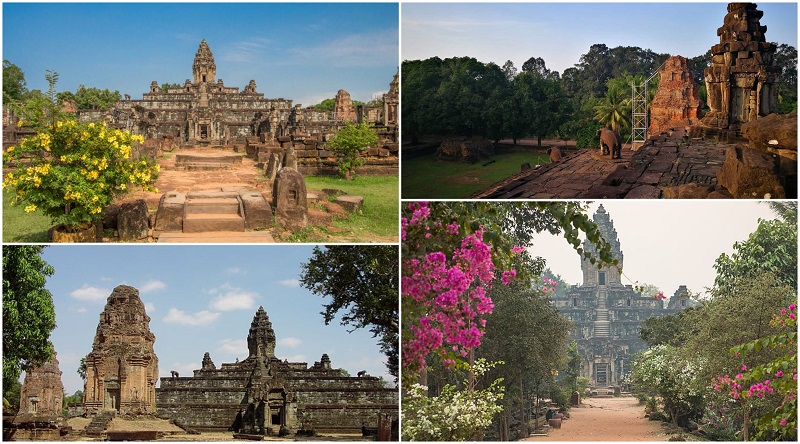
Bakong is part of the Roluos temple group.
It is the first state temple built during the Khmer Empire, right in the heart of the Angkorian capital, Hariharalaya.
The architecture resembles Prah Ko’ design, with four levels of Bakong symbolizing creatures from both Hindu and Buddhist mythology.
At the top, the central sanctuary features a lotus-shaped top.
Later on, other kings contributed to the design of the stone temple adding a garden around Bakong.
16. Wat Athvea

Wat Athvea, also called Prasat Vat Althea, is a Hindu temple located south of Siem Reap.
It is in a more secluded area than the main attractions of Angkor.
This makes it less visited by tourists and more of an appropriate setting for artistic photos.
One of the better-maintained temples, the Wat Athvea perimeter also hosts a functional Buddhist temple.
The garden surrounding it adds to the picturesque of the place.
There are no finished carvings on Wat Athvea, but it does somewhat resemble Angkor Wat architecture.
17. Thommanon
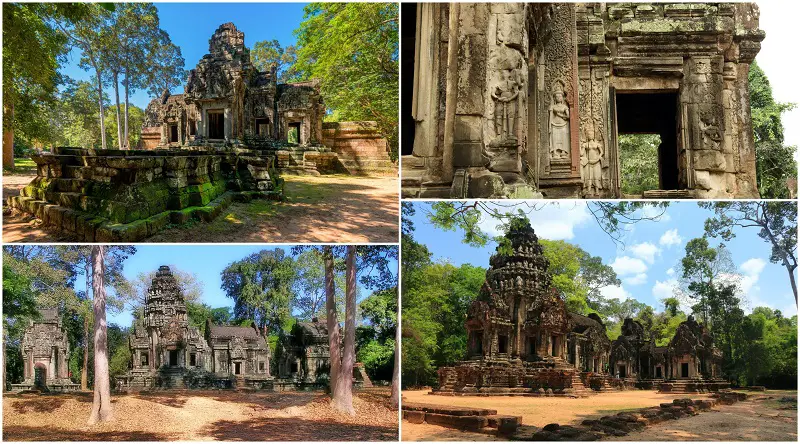
Thommanon is a small, yet very popular and well-maintained Hindu temple of Angkor Wat.
The point of attraction in this temple is a statue of a female devata (deity) wearing traditional clothing and jewelry.
It resembles the statues in Angkor Wat as shown by the decor on the tower.
18. Tep Pranam

Tep Pranam was built as a pagoda from light materials and is located in the vicinity of the Terrace of the Leper King.
As you follow the causeway of laterite to get to the entrance marked by two stones, you’ll notice the cross-shaped terrace.
A 5-meter-tall Buddha stands out, which is actually a reconstruction of the original piece.
Buddhist nuns inhabit an annex of the temple.
19. Ta Som
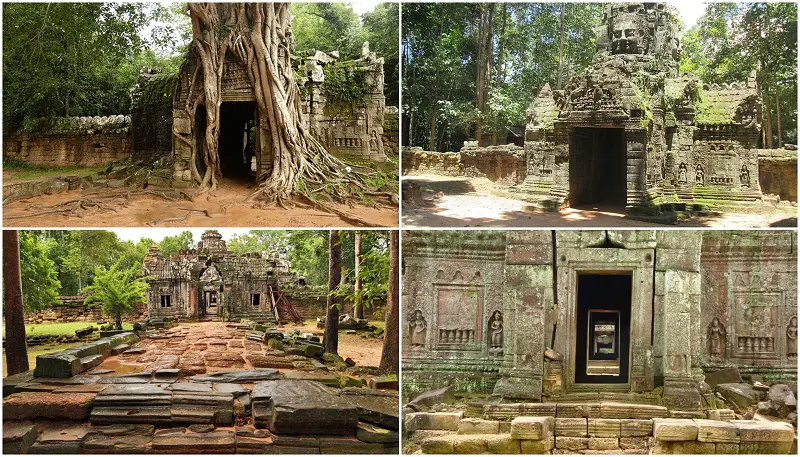
Ta Som is a Buddhist temple of the Angkor complex.
However, its small size is uncharacteristic of the type of temples constructed by King Jayavarman VII.
The ruins now consist of one shrine and laterite walls that enclose it.
Roots of old trees are slowly taking over the temple.
It’s one of the more popular areas to take photos for visitors.
20. Ta Prohm
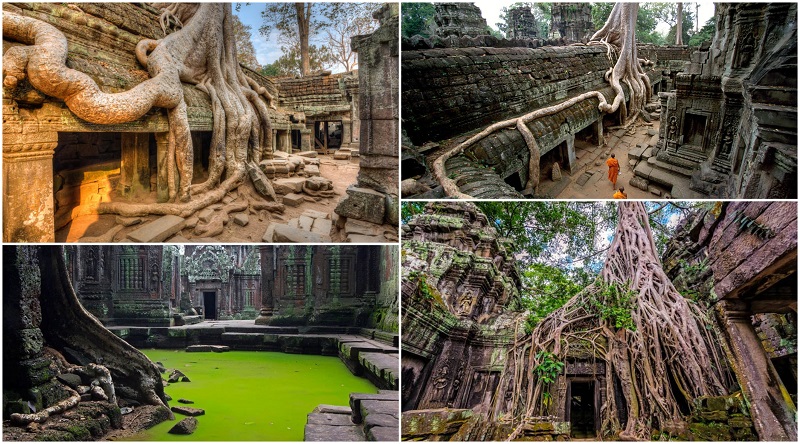
Since Ta Prohm was discovered by European explorers, the ruins of Ta Prohm have been maintained in their original form.
For this reason, the temple is one of the more visited attractions in Angkor.
The beauty and uniqueness of Ta Prohm also reside in the jungle that surrounds it.
Trees are slowly taking over the ruins, casting a deep, mysterious shadow upon them.
Large roots from trees spread like a net around the building.
This aspect alone has inspired many visual artists and writers in their work.
21. Ta Keo
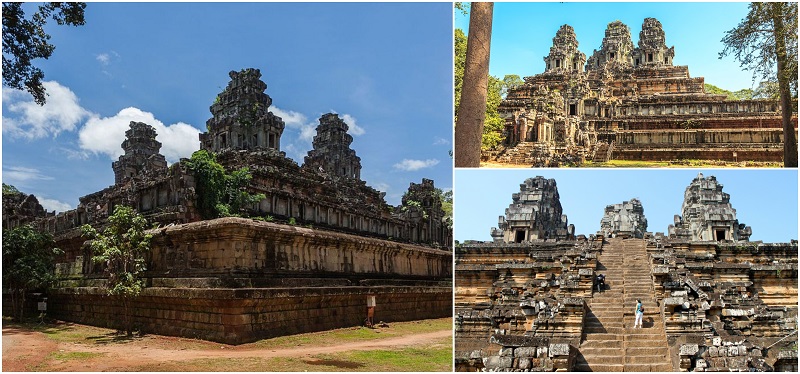
Ta Keo is the first sandstone temple mountain in the history of the Khmer Empire.
The lack of carvings is unlike other Angkorian temples and shows that the construction was never finalized.
Ta Keo comprises of two terraces, a continuous gallery, libraries, and four corner towers.
You can easily walk up the temple and enjoy a view of the Angkor area.
22. Srah Srang

Srah Sran is a reservoir located south of East Barray.
It is part of the Angkorian Complex.
The 10th-century ruins comprise of a laterite and sandstone platform, balustrades, lion sculptures guarding the lake, and a Garuda.
The lake is quite large and still retains water so locals sometimes bathe here.
Srah Srang is a more secluded place than Angkor Wat so it’s a perfect place for photos, especially at sunset.
23. Preah Khan

Preah Khan is a huge Buddhist temple located north of Angkor Wat.
Its significance lies in its architectural features.
It has unique decorative Hindu features, numerous carvings and garuda sculptures.
The 138 acres temple comprises of towers, shrines, courtyards, entryways, connecting corridors and ceremonial rooms.
One of the most prominent parts of the temple is the Hall of Dancers.
24. Pre Rup
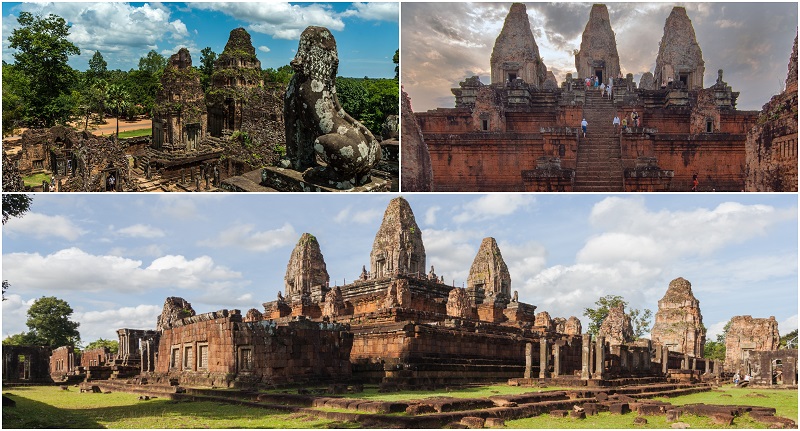
Pre Rup is the last and most underrated temple mountain of Angkor Wat.
Made out of laterite, brick, and sandstone, its name literally means “turn the body”.
This led the Cambodian people to believe that this was a place for funerals.
The temple consists of two enclosures and a pyramid.
Each enclosure features 4 gateway entrances.
There are also three big towers standing in line in the north-south direction and two small towers aligned one level below.
25. Prasat Kravan
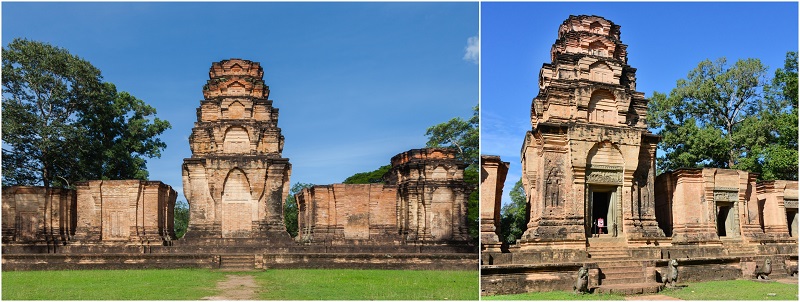
Built in 921, Prasat Kravan is east of Angkor Wat.
A moat surrounds this temple.
The Central Tower is dedicated to Vishnu, while the Northern Tower is dedicated to Lakshmi.
26. Prasat Bei
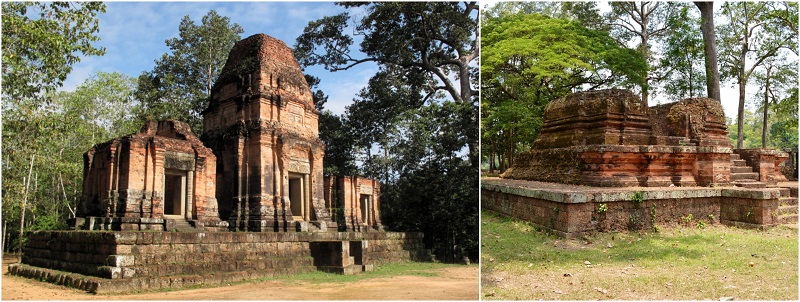
Prasat Bei comprises of three towers made of brick, each dedicated to one of the three most important Hindu gods: Vishnu, Brahma and Shiva.
The unfinished temple’s name literally means “towers of three”.
Its carvings represent the highlights of the temple.
A depiction of Indra in Aravata stands out.
27. Phnom Bakheng
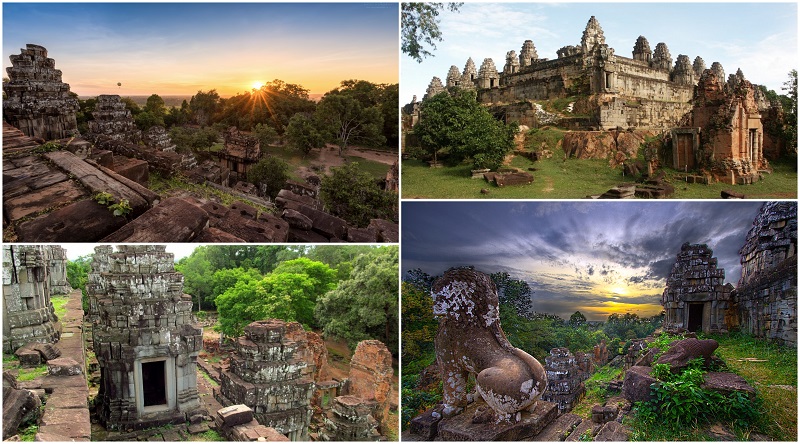
Phnom Bakheng is one of the oldest temple mountains of the Angkorian era.
It was initially the main temple of the Archaeological park.
The temple comprises of a central pyramid made of rock and five sandstone towers.
Each towers bear carvings of Hindu deities and dancers.
Phnom Bakheng is a symbol of Mount Meru, which is the sacred house of Hindu gods.
28. Kleangs
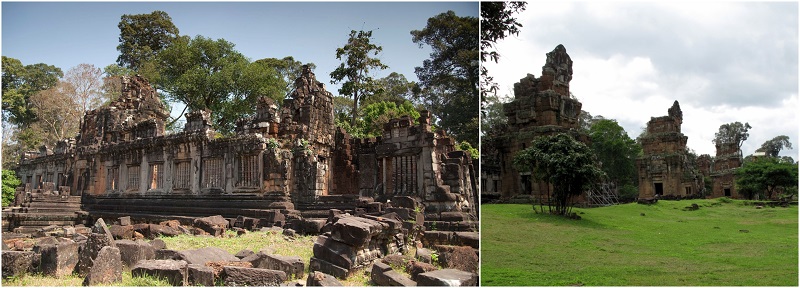
Located just across from the Terrace of Elephants, the South and North Kleangs may have been the archaeological remnants of royal residences.
Ironically though, “kleang” means “storehouse” in Khmer.
The North Kleang was first built in wood but later reconstructed in stone.
South Kleang was only partially built.
The door bears an inscription of an oath of loyalty to the monarch.
The North Kleang in particular had more detail, including a wall made of laterite with tall windows that open into a courtyard.
29. East Mebon
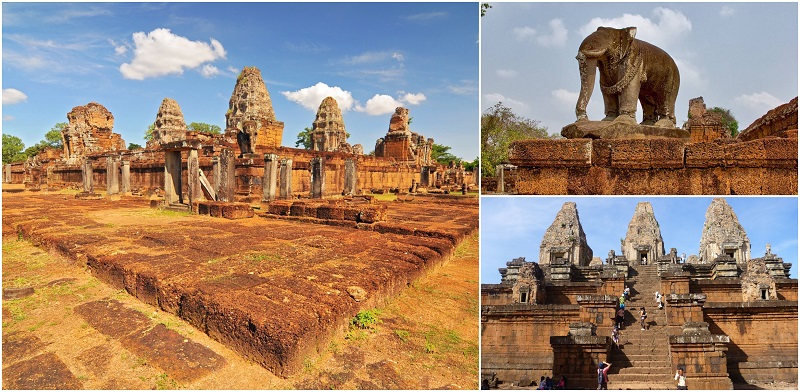
The East Mebon is a Hindu temple mountain of the Khmerian era.
The temple is made of brick, sandstone, laterite, and stucco.
Its made up of 3 enclosures and 5 towers which symbolize Mount Meru.
The temple unfolds on three levels.
East Mebon carvings representing scenes with Indra, Shiva, and Airavata are very intricate and majestic.
Two massive elephants are guarding the tiers and two lions are standing at the bottom of the entrance stairs.
30. Chau Say Tevoda
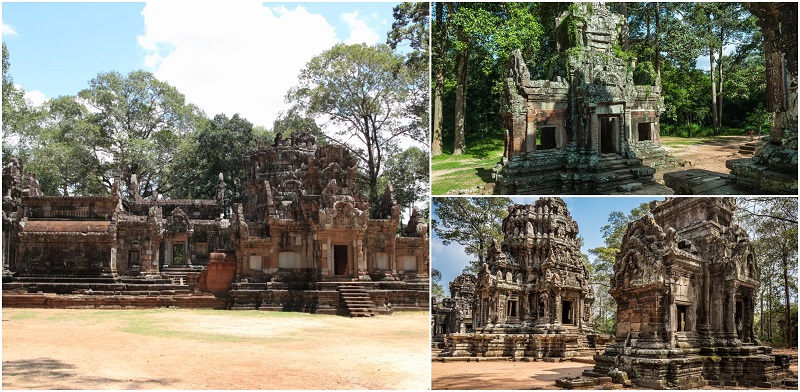
The small Hindu temple of Chau Say Tevoda is a rectangular building that has a sanctuary and entry towers in decay.
The carvings are still visible and represent both Hindu and Buddhist scenes.
Although, Shiva is ultimately the symbol of this temple.
31. Banteay Srei
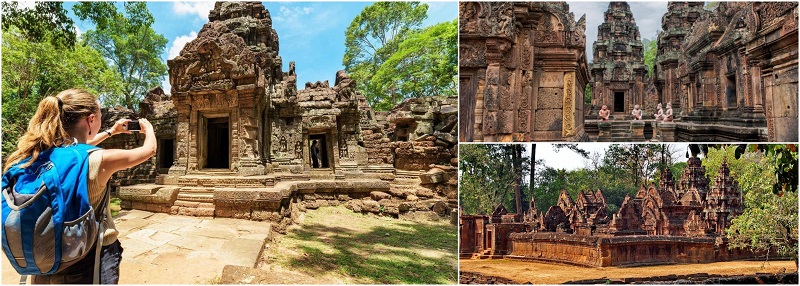
Banteay Srei is located 23 miles north of Angkor Wat.
The delicate carvings on every surface of the temple depict traditional Hindu stories and portraits of celestial nymphs.
Banteay Srei has its own sanctuary featuring three towers and three statues with kneeling human bodies and animal heads.
There are also three enclosures to explore.
32. Banteay Kdei
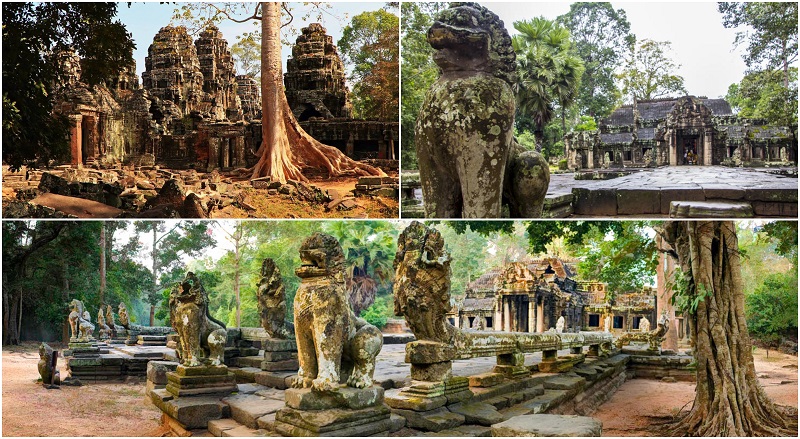
Banteay Kdei is a small Buddhist temple built out of sandstone and laterite.
The temple is in a state of deterioration, but the Buddha carvings are still visible.
The attraction comprises of two galleries, two enclosure walls, and towers.
Its name literally means “A Citadel of Chambers”.
33. Phimeanakas
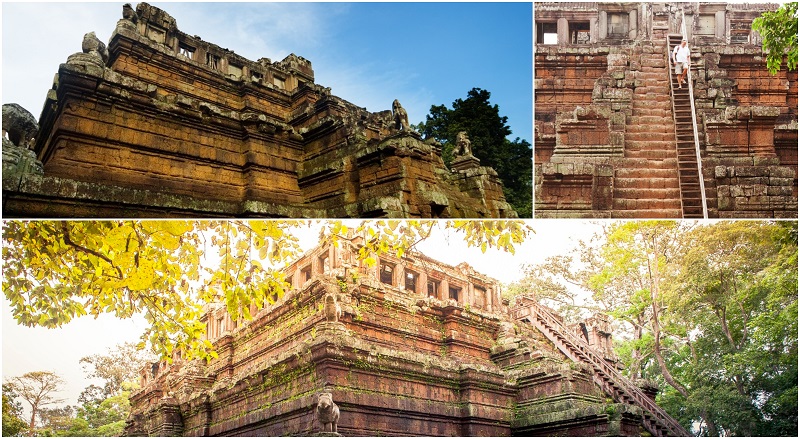
Phimeanakas is a Hindu temple located in the walled city of Angkor Thom.
It means “Celestial Palace,” and, true to its name, it housed the king and royal family in its prime.
While at one time it was a majestic palace, today it’s hard to see evidence of its past glory.
Most of its decorations were broken or stolen.
Nevertheless, if you want a good view of Baphuon, climbing to the top level of Phimeanakas is worth the effort.
Other than the temples, Cambodia has lots to offer.
Try going to a street market and eating frogs, insects, snakes, or tarantulas!
Go to the Floating Village or catch a boat down to Phnom Penh.
Get out into the countryside and taste the palm sugar, watch the people planting rice, or check out some of the orphanages that sell craft that the children make.











